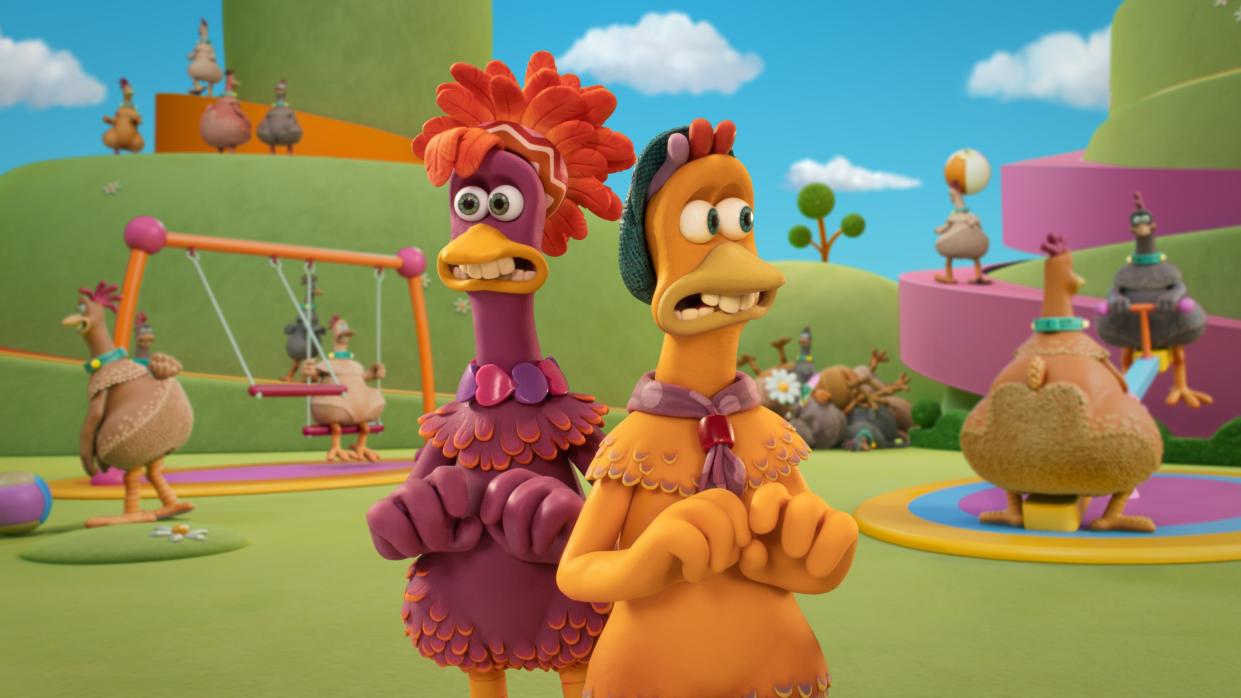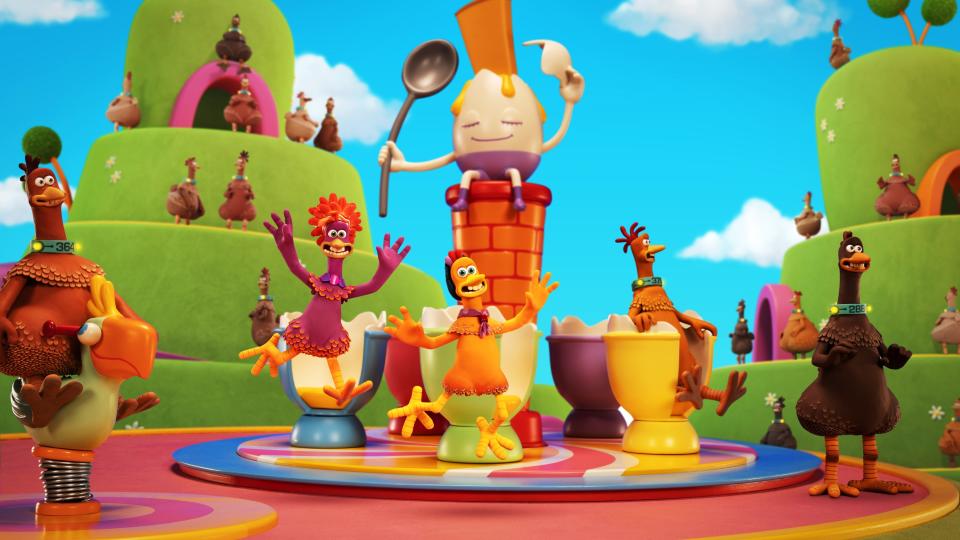‘Chicken Run: Dawn of the Nugget’ Boldly Goes Where No Stop-Motion Movie Has Before

- Oops!Something went wrong.Please try again later.
Two decades after a group of chickens escaped from a farm, they’re back for more. Netflix’s “Chicken Run: Dawn of the Nugget” is a sequel 23 years in the making, and it is much bigger in scope than its predecessor. After all, the film is about breaking back into a farm — one substantially bigger than in the first film. In order to handle the scale of the story and the production, which more than doubled the number of units and character models, Aardman Animations turned to digital tools and virtual production.
“We couldn’t achieve the scope and scale of this film 20 years ago because CG wasn’t a reliable source,” animation supervisor Ian Whitlock told IndieWire during a visit to the set of the film at Aardman’s studios in Bristol, U.K. “But even with CG, we are still very tight on the style of the animation. We look at CG shots the same way we do stop motion shots.”
More from IndieWire
Nobody Thought to Update the 'Rudolph the Red-Nosed Reindeer' Rights for the Streaming Age
Producer Metro Boomin Says 'Spider-Verse' Song 'Am I Dreaming' Started with a 'Grand Champion' Sound
That’s the key to the new “Chicken Run”: to respect and stick to the limitations of stop motion. “The CG chickens can’t do anything beyond what the physical ones can do,” Whitlock continued. This also applies to the stop motion itself. Even if technology has advanced, the characters act like they did two decades ago, with the animators making sure they don’t make the shots look slicker. Other than certain shots, the majority of the film is shot on twos. “When we first started testing, it was too smooth. So we needed to basically get the chunk kind of feel back into it.” Still, Whitlock wants to reassure fans that it is all about the characters, and it feels like they never left. “They still have the same heart and moves and mannerisms that we’ve given them, so they are the same characters.”
In “Chicken Run: Dawn of the Nugget” we catch up on Ginger and the rest of the chickens, who now live on an idyllic island free of humans and peril. But after a few years, there’s a revolution in the food industry that poses a real threat to all of chickenkind: nuggets. This forces Ginger to assemble a squad to break into a massive chicken farm where they face new and familiar dangers. Where the first film employed 30 sets, the sequel used 120 sets — from the elaborate island where the chickens live to the massive factory compound that they break into.
For director of photography Charles Copping, the true breakthrough in managing all these big sets was the use of virtual production. “First Man” was the first Aardman film to use the technology, but it became the key to “Chicken Run: Dawn of the Nugget.” Essentially, virtual production allows filmmakers to visualize fully rendered visual effects on digitally scanned versions of live-action sets. What it means for this film is being able to plan out sets and shots before the puppets start moving, saving a lot of time.
“We’ve embraced new technology,” Copping said. “We have software that tracks the camera position, and we can see real-time the virtual production which starts off as a sort of a pre-vis world, but as the CGI department finesses it all, we get a real-time representation of what’s going to be beyond the characters in the digital backgrounds.”

This is a big time-saver, as there is no need to wait until post to see how certain shots will look, and it allows the CG team to work together with the team on the physical sets to make sure they’re on the same page. Another big time-saving development since the first film was a relatively simple one: digital photography. As Copping explained, in the first film, the animators tried not to take as many risks “because you couldn’t see it until it came back the next day. And then once you’re locked in, you know you’re waiting a week for the shot to be done in the rush to come back.” For the new film, the animators could see exactly how their shots would end up, analyze, and adjust immediately.
This makes for a faster production. In the first “Chicken Run,” animators completed an average of one second of film a week. For the sequel, this was increased to an average of one second of film a day. Digital technology helped, but it was also advancements in how the puppets themselves worked that allowed this. Though Aardman is renowned for its claymation and plasticine puppets, things have changed a bit. “Technology’s moved on greatly since the first film, and the types of materials that are available to us have expanded, as have the techniques that we use,” team leader for puppet making Nigel Leach explained. “The way we make the chickens on this is a very different way than we made the chickens on the first film.”
The puppets now use silicones and polyurethane plastics in addition to plasticine. The cores of the puppets — an armature skeleton not unlike those in the “Pinocchio” puppets — are 3D printed, and the production of a puppet is faster. A single chicken took between two and three months to make back in the ’90s, but now it’s between four and six weeks. And the use of skeletons allows the puppets to hold a pose, which makes it faster and easier for the animators to do one shot after another rather than having to completely reset.
Though all the characters from the original return, they won’t necessarily all sound the same. There are some big casting changes happening in “Chicken Run: Dawn of the Nugget,” like Zachary Levi replacing Mel Gibson, and Thandiwe Newton replacing Julia Sawalha. For director Sam Fell, it was important to be able to look at this film with fresh eyes. “Let’s just start from scratch and just imagine that we could change everybody,” he said. “Let’s just see what still works, what the correct casting choice for this character is now.”
Still, for the animators who have to work with the new voices, nothing changed. This is thanks to character bibles, which Whitlock helped create: “The character bible allows any animator coming in, especially people who haven’t done ‘Chicken Run’ before, to pick up right as if they were part of the original team all along.” The bible includes everything from initial character sketches to a gallery of poses and facial expressions, walk cycles, and movement tests. This means that even if the voices of the characters change, their acting remains the same.
This includes one key character returning in the sequel: Ms. Tweedy. The evil farm owner is now taking a different approach, but she remains as dedicated to making chicken-based products as ever. While Tweedy’s return seems obvious now, that wasn’t always the case. “We originally had a different villain for a year, and it was just kind of flat,” Fell said. “It just didn’t quite have the juice. It wasn’t as interesting.” Instead, the team went back to the first film’s villain, realizing she is as big a part of this franchise as Ginger. “I think she’s kind of like our Cruella. She’s just downright evil.”
Best of IndieWire
Where to Watch This Week's New Movies, Including 'Wonka' and 'The Zone of Interest'
2023 Movies Shot on Film: From 'Oppenheimer' to 'Killers of the Flower Moon' and 'Maestro'
Quentin Tarantino's Favorite Movies: 59 Films the Director Wants You to See
Sign up for Indiewire's Newsletter. For the latest news, follow us on Facebook, Twitter, and Instagram.

